oil MITSUBISHI iMiEV 2016 1.G Owners Manual
[x] Cancel search | Manufacturer: MITSUBISHI, Model Year: 2016, Model line: iMiEV, Model: MITSUBISHI iMiEV 2016 1.GPages: 296, PDF Size: 7.79 MB
Page 194 of 296
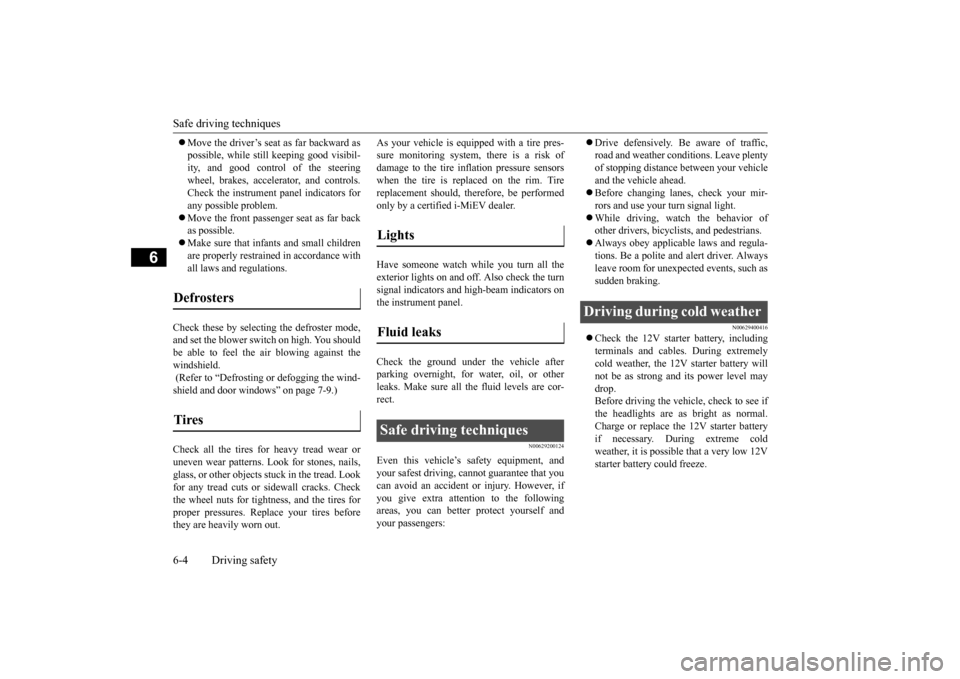
Safe driving techniques 6-4 Driving safety
6
Move the driver’s seat as far backward as possible, while still
keeping good visibil-
ity, and good control of the steering wheel, brakes, accele
rator, and controls.
Check the instrument panel indicators forany possible problem. Move the front passe
nger seat as far back
as possible. Make sure that infa
nts and small children
are properly restrained in accordance with all laws and regulations.
Check these by selecti
ng the defroster mode,
and set the blower swit
ch on high. You should
be able to feel the air blowing against the windshield. (Refer to “Defrosting or defogging the wind- shield and door windows” on page 7-9.) Check all the tires for heavy tread wear or uneven wear patterns.
Look for stones, nails,
glass, or other objects
stuck in the tread. Look
for any tread cuts or sidewall cracks. Check the wheel nuts for tightness, and the tires for proper pressures. Replace your tires beforethey are heavily worn out.
As your vehicle is equi
pped with a tire pres-
sure monitoring system, there is a risk ofdamage to the tire inflation pressure sensors when the tire is replaced on the rim. Tire replacement should, th
erefore, be performed
only by a certified i-MiEV dealer. Have someone watch while you turn all the exterior lights on and off. Also check the turn signal indicators and
high-beam indicators on
the instrument panel. Check the ground under the vehicle after parking overnight, for wa
ter, oil, or other
leaks. Make sure all the fluid levels are cor- rect.
N00629200124
Even this vehicle’s safety equipment, andyour safest driving, cannot guarantee that youcan avoid an accident or injury. However, if you give extra attention to the following areas, you can better protect yourself andyour passengers:
Drive defensively. Be aware of traffic, road and weather conditions. Leave plentyof stopping distance between your vehicle and the vehicle ahead. Before changing lanes, check your mir- rors and use your turn signal light. While driving, watch the behavior of other drivers, bicyc
lists, and pedestrians.
Always obey applicable
laws and regula-
tions. Be a polite and alert driver. Always leave room for unexpected events, such as sudden braking.
N00629400416
Check the 12V starter battery, including terminals and cables. During extremely cold weather, the 12V starter battery willnot be as strong and
its power level may
drop. Before driving the vehicle, check to see ifthe headlights are as bright as normal. Charge or replace the 12V starter battery if necessary. During extreme coldweather, it is possibl
e that a very low 12V
starter battery could freeze.
Defrosters Tires
Lights Fluid leaks Safe driving techniques
Driving during cold weather
BK0220401US.book 4 ページ 2015年6月3日 水曜日 午前7時42分
Page 195 of 296
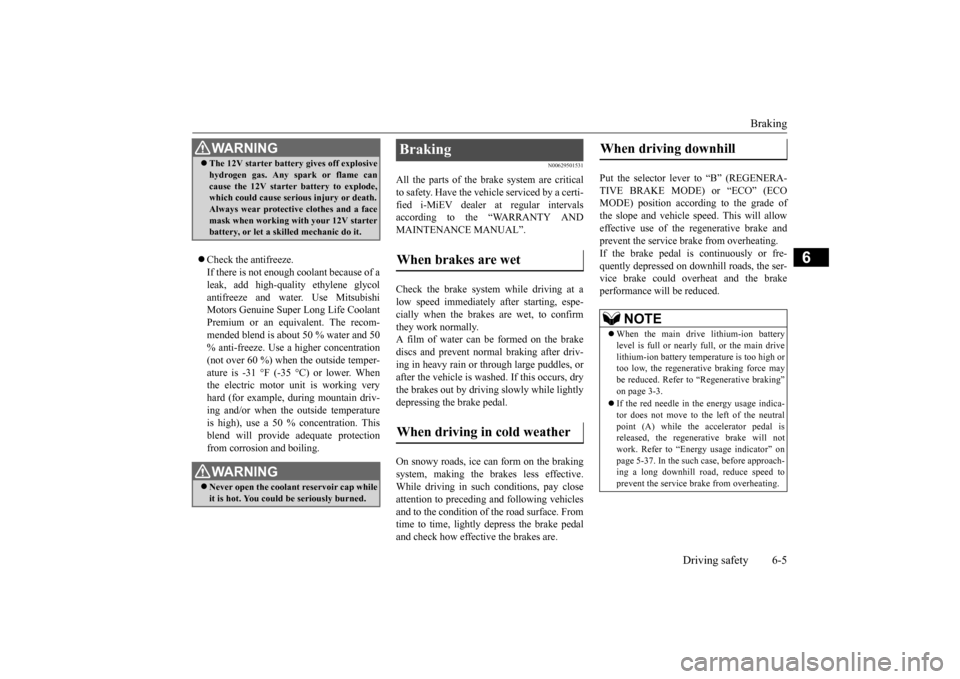
Braking
Driving safety 6-5
6
Check the antifreeze. If there is not enough coolant because of aleak, add high-quality ethylene glycol antifreeze and water. Use Mitsubishi Motors Genuine Super Long Life CoolantPremium or an equivalent. The recom- mended blend is abou
t 50 % water and 50
% anti-freeze. Use a
higher concentration
(not over 60 %) when the outside temper- ature is -31 °F (-35 °C) or lower. When the electric motor unit is working veryhard (for example, during mountain driv- ing and/or when the outside temperature is high), use a 50 %
concentration. This
blend will provide
adequate protection
from corrosion and boiling.
N00629501531
All the parts of the brake system are criticalto safety. Have the vehicle serviced by a certi- fied i-MiEV dealer at regular intervalsaccording to the “WARRANTY AND MAINTENANCE MANUAL”. Check the brake system while driving at a low speed immediately
after starting, espe-
cially when the brakes are wet, to confirm they work normally. A film of water can be formed on the brakediscs and prevent normal braking after driv- ing in heavy rain or through large puddles, or after the vehicle is washed. If this occurs, drythe brakes out by driving slowly while lightly depressing the brake pedal. On snowy roads, ice can form on the braking system, making the brak
es less effective.
While driving in such conditions, pay closeattention to preceding
and following vehicles
and to the condition of the road surface. From time to time, lightly
depress the brake pedal
and check how effective the brakes are.
Put the selector lever to “B” (REGENERA- TIVE BRAKE MODE) or “ECO” (ECO MODE) position according to the grade ofthe slope and vehicle sp
eed. This will allow
effective use of the regenerative brake and prevent the service brake from overheating.If the brake pedal is continuously or fre- quently depressed on downhill roads, the ser- vice brake could overheat and the brake performance will be reduced.
WA R N I N G The 12V starter batter
y gives off explosive
hydrogen gas. Any spark or flame cancause the 12V starter battery to explode,which could cause serious injury or death. Always wear protecti
ve clothes and a face
mask when working wi
th your 12V starter
battery, or let a skil
led mechanic do it.
WA R N I N GNever open the coolan
t reservoir cap while
it is hot. You could be seriously burned.
Braking When brakes are wet When driving in cold weather
When driving downhill
NOTE
When the main drive lithium-ion battery level is full or nearly full, or the main drivelithium-ion battery temp
erature is too high or
too low, the regenerative braking force may be reduced. Refer to “Regenerative braking”on page 3-3. If the red needle in the energy usage indica- tor does not move to the left of the neutral point (A) while the
accelerator pedal is
released, the regenerative brake will notwork. Refer to “Ener
gy usage indicator” on
page 5-37. In the such
case, before approach-
ing a long downhill
road, reduce speed to
prevent the service brake from overheating.
BK0220401US.book 5 ページ 2015年6月3日 水曜日 午前7時42分
Page 197 of 296
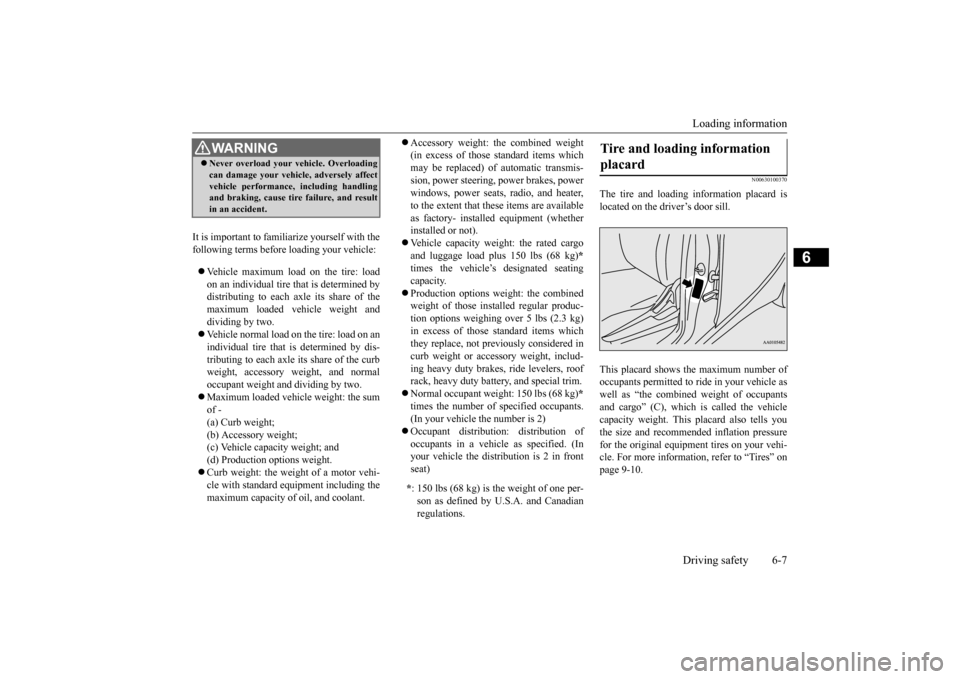
Loading information Driving safety 6-7
6
It is important to famil
iarize yourself with the
following terms before loading your vehicle: Vehicle maximum load on the tire: load on an individual tire that is determined bydistributing to each axle its share of the maximum loaded vehicle weight and dividing by two. Vehicle normal load on the tire: load on an individual tire that is determined by dis- tributing to each axle its share of the curbweight, accessory weight, and normal occupant weight and dividing by two. Maximum loaded vehicle weight: the sum of - (a) Curb weight; (b) Accessory weight;(c) Vehicle capacity weight; and (d) Production options weight. Curb weight: the weight of a motor vehi- cle with standard e
quipment including the
maximum capacity of oil, and coolant.
Accessory weight: the combined weight (in excess of those st
andard items which
may be replaced) of automatic transmis- sion, power steering, power brakes, power windows, power seats,
radio, and heater,
to the extent that these items are available as factory- installe
d equipment (whether
installed or not). Vehicle capacity weight: the rated cargo and luggage load plus 150 lbs (68 kg)
*
times the vehicle’s designated seating capacity. Production options weight: the combined weight of those installed regular produc- tion options weighing over 5 lbs (2.3 kg) in excess of those standard items whichthey replace, not prev
iously considered in
curb weight or accessory weight, includ- ing heavy duty brakes,
ride levelers, roof
rack, heavy duty battery, and special trim. Normal occupant weight: 150 lbs (68 kg)
*
times the number of specified occupants.(In your vehicle the number is 2) Occupant distributi
on: distribution of
occupants in a vehicle as specified. (Inyour vehicle the distribution is 2 in front seat)
N00630100370
The tire and loading information placard is located on the driver’s door sill. This placard shows the maximum number of occupants permitted to
ride in your vehicle as
well as “the combined
weight of occupants
and cargo” (C), which
is called the vehicle
capacity weight. This
placard also tells you
the size and recomme
nded inflation pressure
for the original equipment tires on your vehi-cle. For more information, refer to “Tires” on page 9-10.
WA R N I N G Never overload your ve
hicle. Overloading
can damage your vehicl
e, adversely affect
vehicle performance, including handlingand braking, cause tire failure, and result in an accident.
* : 150 lbs (68 kg) is the weight of one per- son as defined by U.S.A. and Canadian regulations.
Tire and loading information placard
BK0220401US.book 7 ページ 2015年6月3日 水曜日 午前7時42分
Page 263 of 296
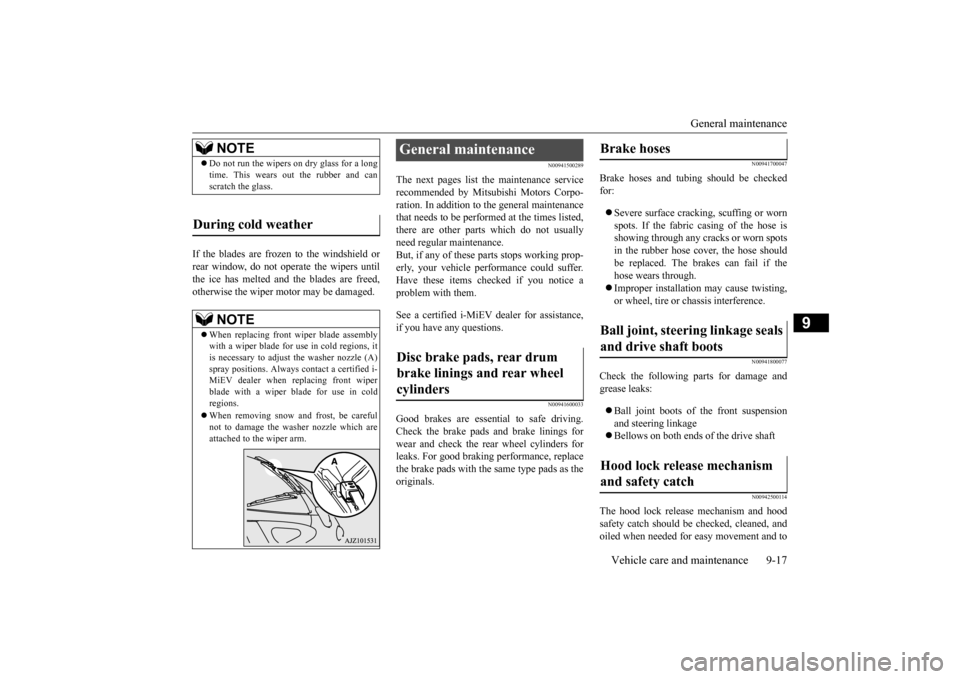
General maintenance
Vehicle care and maintenance 9-17
9
If the blades are frozen to the windshield or rear window, do not operate the wipers until the ice has melted and the blades are freed,otherwise the wiper mo
tor may be damaged.
N00941500289
The next pages list th
e maintenance service
recommended by Mitsubishi Motors Corpo- ration. In addition to the general maintenancethat needs to be performed at the times listed, there are other parts which do not usually need regular maintenance.But, if any of these parts stops working prop- erly, your vehicle performance could suffer. Have these items checked if you notice a problem with them. See a certified i-MiEV dealer for assistance, if you have any questions.
N00941600033
Good brakes are essential to safe driving. Check the brake pads and brake linings for wear and check the rear wheel cylinders forleaks. For good braking performance, replace the brake pads with the same type pads as the originals.
N00941700047
Brake hoses and tubing should be checked for: Severe surface cracki
ng, scuffing or worn
spots. If the fabric casing of the hose isshowing through any cracks or worn spots in the rubber hose cover, the hose should be replaced. The brakes can fail if the hose wears through. Improper installation may cause twisting, or wheel, tire or
chassis interference.
N00941800077
Check the following parts for damage and grease leaks: Ball joint boots of the front suspension and steering linkage Bellows on both ends of the drive shaft
N00942500114
The hood lock release mechanism and hood safety catch should be
checked, cleaned, and
oiled when needed for easy movement and to
NOTE
Do not run the wipers on dry glass for a long time. This wears out the rubber and canscratch the glass.
During cold weather
NOTE
When replacing front wiper blade assembly with a wiper blade for use in cold regions, it is necessary to adjust the washer nozzle (A)
contact a certified i-
MiEV dealer when re
placing front wiper
blade with a wiper blade for use in cold regions. When removing snow and frost, be careful not to damage the wash
er nozzle which are
attached to the wiper arm.
General maintenance Disc brake pads, rear drum brake linings and rear wheel cylinders
Brake hoses Ball joint, steering linkage seals and drive shaft boots Hood lock release mechanism and safety catch
BK0220401US.book 17 ページ 2015年6月3日 水曜日 午前7時42分
Page 267 of 296
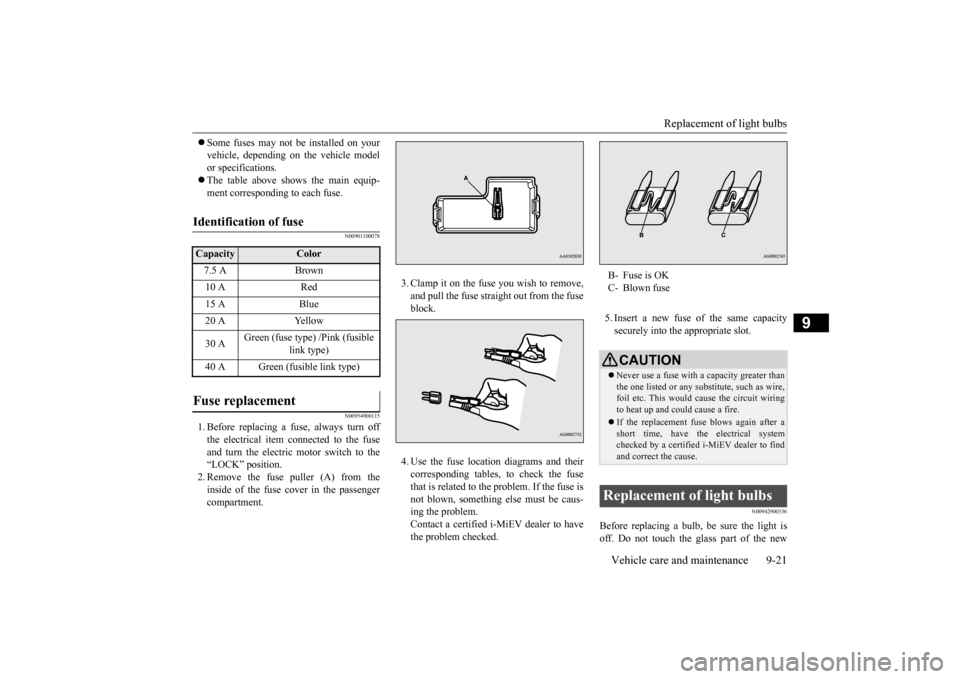
Replacement of light bulbs
Vehicle care and maintenance 9-21
9
Some fuses may not be installed on your vehicle, depending on
the vehicle model
or specifications. The table above show
s the main equip-
ment corresponding to each fuse.
N00901100078 N00954900115
1. Before replacing a fuse, always turn off the electrical item connected to the fuse and turn the electric motor switch to the “LOCK” position.2. Remove the fuse puller (A) from the inside of the fuse cover in the passenger compartment.
3. Clamp it on the fuse you wish to remove, and pull the fuse straight out from the fuseblock. 4. Use the fuse location diagrams and their corresponding tables, to check the fuse that is related to the problem. If the fuse is not blown, something
else must be caus-
ing the problem.Contact a certified i-MiEV dealer to have the problem checked.
5. Insert a new fuse of the same capacity securely into the appropriate slot.
N00942900336
Before replacing a bulb,
be sure the light is
off. Do not touch the glass part of the new
Identification of fuse Capacity
Color
7.5 A Brown 10 A Red 15 A Blue 20 A Yellow 30 A
Green (fuse type) /Pink (fusible
link type)
40 A Green (fusible link type)
Fuse replacement
B- Fuse is OK C- Blown fuseCAUTION Never use a fuse with a capacity greater than the one listed or any substitute, such as wire, foil etc. This would
cause the circuit wiring
to heat up and could cause a fire. If the replacement fuse blows again after a short time, have the electrical systemchecked by a certified i-MiEV dealer to find and correct the cause.
Replacement of light bulbs
BK0220401US.book 21 ページ 2015年6月3日 水曜日 午前7時42分
Page 268 of 296
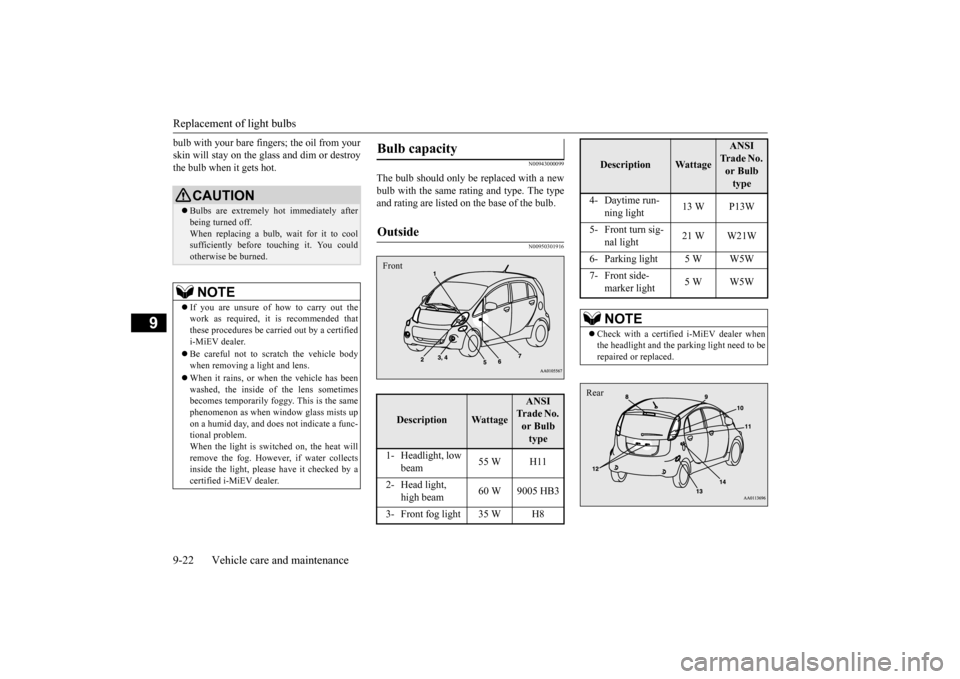
Replacement of light bulbs 9-22 Vehicle care and maintenance
9
bulb with your bare fingers; the oil from your skin will stay on the glass and dim or destroythe bulb when it gets hot.
N00943000099
The bulb should only be replaced with a new bulb with the same rating and type. The type and rating are listed on the base of the bulb.
N00950301916
CAUTION Bulbs are extremely hot immediately after being turned off.When replacing a bulb, wait for it to cool sufficiently before t
ouching it. You could
otherwise be burned.NOTE
If you are unsure of how to carry out the work as required, it is recommended that these procedures be ca
rried out by
a certified
i-MiEV dealer. Be careful not to scratch the vehicle body when removing a light and lens. When it rains, or wh
en the vehicle has been
washed, the inside of the lens sometimesbecomes temporarily foggy. This is the same phenomenon as when window glass mists up on a humid day, and does not indicate a func-tional problem. When the light is switched on, the heat will remove the fog. However, if water collectsinside the light, please
have it checked by a
certified i-MiEV dealer.
Bulb capacity Outside
Description
Wattage
ANSI Tr a d e N o . or Bulb type
1- Headlight, low
beam
55 W H11
2- Head light,
high beam
60 W 9005 HB3
3- Front fog light 35 W H8Front
4- Daytime run-
ning light
13 W P13W
5- Front turn sig-
nal light
21 W W21W
6- Parking light 5 W W5W 7- Front side-
marker light
5 W W5W
NOTE
Check with a certified i-MiEV dealer when the headlight and the parking light need to be repaired or replaced.Description
Wattage
ANSI Tr a d e N o . or Bulb type
Rear
BK0220401US.book 22 ページ 2015年6月3日 水曜日 午前7時42分
Page 275 of 296
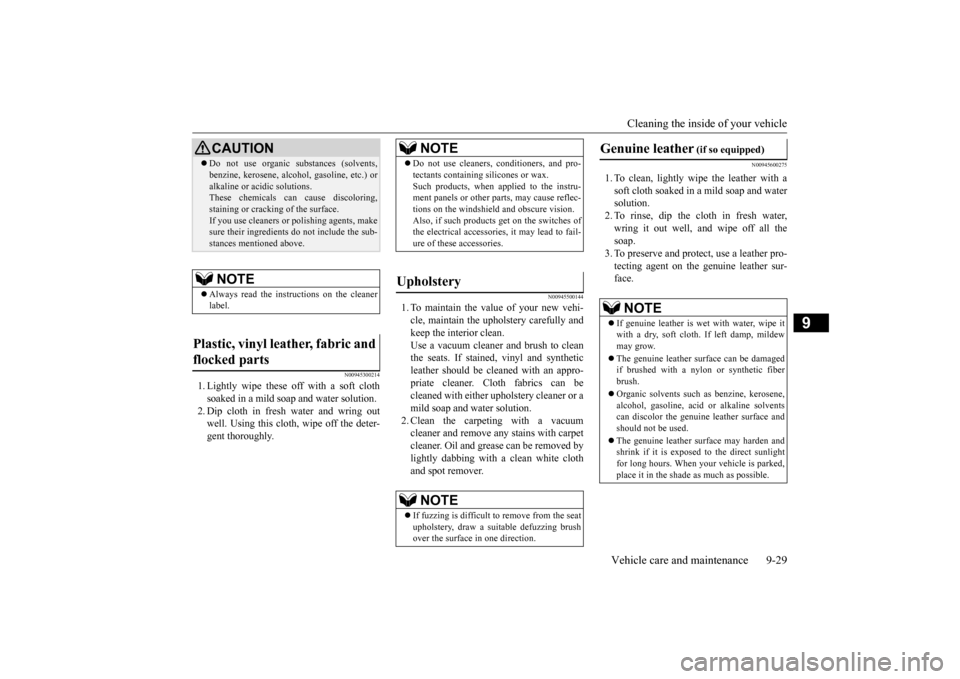
Cleaning the inside of your vehicle
Vehicle care and maintenance 9-29
9
N00945300214
1. Lightly wipe these off with a soft cloth soaked in a mild soap and water solution. 2. Dip cloth in fresh water and wring out well. Using this cloth,
wipe off the deter-
gent thoroughly.
N00945500144
1. To maintain the value of your new vehi-cle, maintain the upholstery carefully andkeep the interior clean. Use a vacuum cleaner
and brush to clean
the seats. If stained,
vinyl and synthetic
leather should be cleaned with an appro- priate cleaner. Cloth fabrics can be cleaned with either upholstery cleaner or amild soap and water solution. 2. Clean the carpeting with a vacuum cleaner and remove any stains with carpetcleaner. Oil and grea
se can be removed by
lightly dabbing with
a clean white cloth
and spot remover.
N00945600275
1. To clean, lightly wi
pe the leather with a
soft cloth soaked in a mild soap and water solution.2. To rinse, dip the cloth in fresh water, wring it out well, and wipe off all the soap. 3. To preserve and prot
ect, use a leather pro-
tecting agent on the genuine leather sur- face.
CAUTION Do not use organic s
ubstances (solvents,
benzine, kerosene, alc
ohol, gasoline, etc.) or
alkaline or acidic solutions.These chemicals can
cause discoloring,
staining or cracking of the surface. If you use cleaners or polishing agents, makesure their ingredients do not include the sub- stances mentioned above.NOTE
Always read the instru
ctions on the cleaner
label.
Plastic, vinyl leat
her, fabric and
flocked parts
NOTE
Do not use cleaners,
conditioners, and pro-
tectants containi
ng silicones or wax.
Such products, when applied to the instru-ment panels or other pa
rts, may cause reflec-
tions on the windshiel
d and obscure vision.
Also, if such products
get on the switches of
the electrical accessories, it may lead to fail- ure of these accessories.
Upholstery
NOTE
If fuzzing is difficult to remove from the seat upholstery, draw a suit
able defuzzing brush
over the surface in one direction.
Genuine leather
(if so equipped)
NOTE
If genuine leather is we
t with water, wipe it
with a dry, soft cloth. If left damp, mildew may grow. The genuine leather su
rface can be damaged
if brushed with a nylon or synthetic fiber brush. Organic solvents such as benzine, kerosene, alcohol, gasoline, acid
or alkaline solvents
can discolor the genuine
leather surface and
should not be used. The genuine leather su
rface may harden and
shrink if it is exposed to the direct sunlight for long hours. When your vehicle is parked,place it in the shade as much as possible.
BK0220401US.book 29 ページ 2015年6月3日 水曜日 午前7時42分
Page 276 of 296
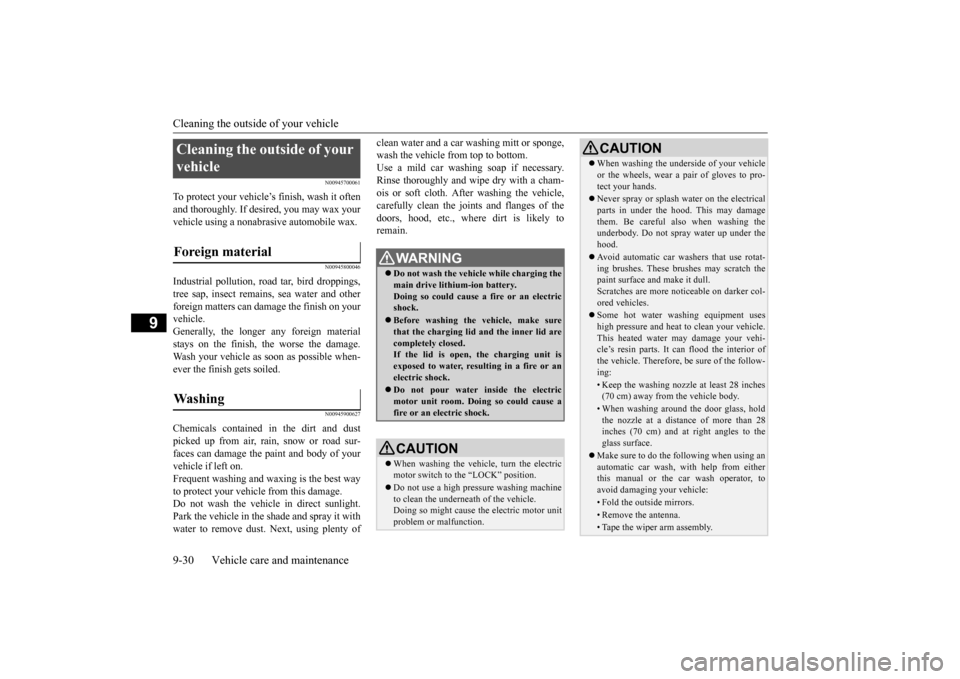
Cleaning the outside of your vehicle 9-30 Vehicle care and maintenance
9
N00945700061
To protect your vehicle’s finish, wash it often and thoroughly. If desired, you may wax your vehicle using a nonabras
ive automobile wax.
N00945800046
Industrial pollution, road tar, bird droppings, tree sap, insect remain
s, sea water and other
foreign matters can damage the finish on your vehicle.Generally, the longer any foreign material stays on the finish, the worse the damage. Wash your vehicle as soon as possible when-ever the finish gets soiled.
N00945900627
Chemicals cont
ained in the dirt and dust
picked up from air, rain, snow or road sur- faces can damage the paint and body of your vehicle if left on.Frequent washing and wa
xing is the best way
to protect your vehicl
e from this damage.
Do not wash the vehicle in direct sunlight.Park the vehicle in the shade and spray it with water to remove dust.
Next, using plenty of
clean water and a car washing mitt or sponge, wash the vehicle from top to bottom.Use a mild car washing soap if necessary. Rinse thoroughly and wipe
dry with a cham-
ois or soft cloth. Af
ter washing the vehicle,
carefully clean the join
ts and flanges of the
doors, hood, etc., wher
e dirt is likely to
remain.
Cleaning the outside of your vehicle Foreign material Wa s h i n g
WA R N I N G Do not wash the vehicle while charging the main drive lithium-ion battery. Doing so could cause a fire or an electric shock. Before washing the vehicle, make sure that the charging lid and the inner lid arecompletely closed. If the lid is open, the charging unit is exposed to water, resulting in a fire or anelectric shock. Do not pour water inside the electric motor unit room. Doing so could cause a fire or an el
ectric shock.
CAUTIONWhen washing the vehicle, turn the electric motor switch to the “LOCK” position. Do not use a high pressure washing machine to clean the underneath of the vehicle. Doing so might cause th
e electric motor unit
problem or malfunction.
When washing the underside of your vehicle or the wheels, wear a pair of gloves to pro-tect your hands. Never spray or splash
water on the electrical
parts in under the hood. This may damagethem. Be careful also when washing the underbody. Do not spray water up under the hood. Avoid automatic car washers that use rotat- ing brushes. These br
ushes may scratch the
paint surface and make it dull. Scratches are more not
iceable on darker col-
ored vehicles. Some hot water wash
ing equipment uses
high pressure and heat
to clean your vehicle.
This heated water ma
y damage your vehi-
cle’s resin parts. It
can flood the interior of
the vehicle. Therefore,
be sure of the follow-
ing:• Keep the washing nozzle at least 28 inches(70 cm) away from the vehicle body.• When washing around the door glass, holdthe nozzle at a distance of more than 28 inches (70 cm) and at right angles to the glass surface.
Make sure to do the following when using an automatic car wash, with help from eitherthis manual or the car wash operator, to avoid damaging your vehicle:• Fold the outside mirrors.• Remove the antenna.• Tape the wiper arm assembly.CAUTION
BK0220401US.book 30 ページ 2015年6月3日 水曜日 午前7時42分
Page 278 of 296
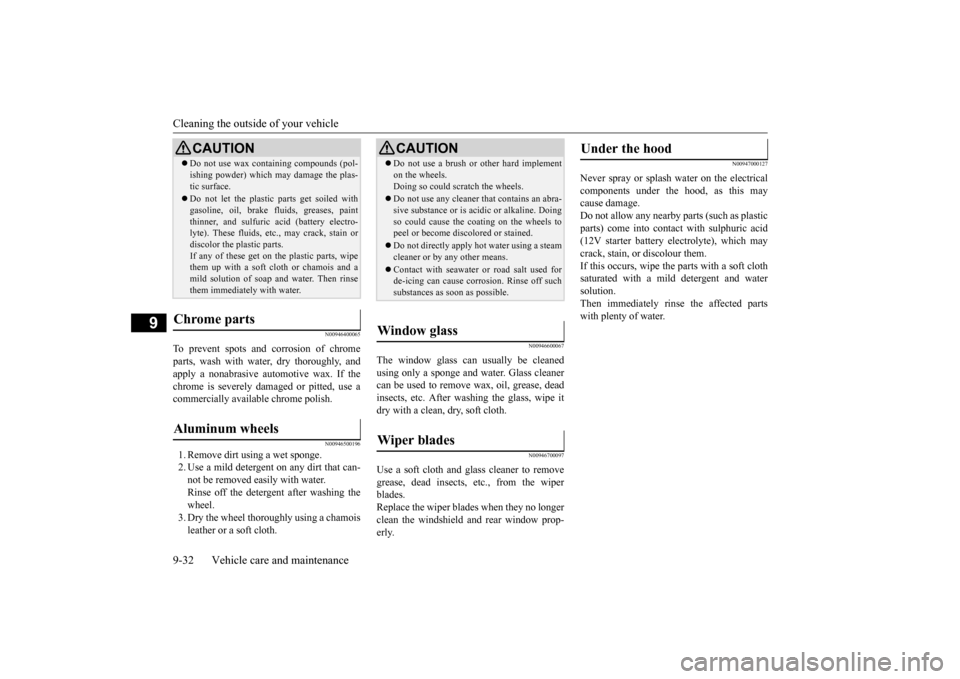
Cleaning the outside of your vehicle 9-32 Vehicle care and maintenance
9
N00946400065
To prevent spots and corrosion of chrome parts, wash with water, dry thoroughly, andapply a nonabrasive automotive wax. If the chrome is severely da
maged or pitted, use a
commercially available chrome polish.
N00946500196
1. Remove dirt using a wet sponge.2. Use a mild detergent on any dirt that can-not be removed ea
sily with water.
Rinse off the detergent after washing the wheel.3. Dry the wheel thoroughly using a chamois leather or a soft cloth.
N00946600067
The window glass can
usually be cleaned
using only a sponge and
water. Glass cleaner
can be used to remove wax, oil, grease, deadinsects, etc. After washing the glass, wipe it dry with a clean, dry, soft cloth.
N00946700097
Use a soft cloth and gl
ass cleaner to remove
grease, dead insects, etc., from the wiper blades.Replace the wiper blades when they no longer clean the windshield and rear window prop- erly.
N00947000127
Never spray or splash
water on the electrical
components under the hood, as this may cause damage.Do not allow any nearby
parts (such as plastic
parts) come into contact with sulphuric acid (12V starter battery el
ectrolyte), which may
crack, stain, or discolour them. If this occurs, wipe the parts with a soft cloth saturated with a mild detergent and water solution. Then immediately rinse the affected partswith plenty of water.
Do not use wax containing compounds (pol- ishing powder) which ma
y damage the plas-
tic surface. Do not let the plastic parts get soiled with gasoline, oil, brake fl
uids, greases, paint
thinner, and sulfuric
acid (battery electro-
lyte). These fluids, et
c., may crack, stain or
discolor the plastic parts.If any of these get on the plastic parts, wipe them up with a soft cloth or chamois and a mild solution of soap and water. Then rinsethem immediately with water.
Chrome parts Aluminum wheels
CAUTION
CAUTION Do not use a brush or other hard implement on the wheels.Doing so could scratch the wheels. Do not use any cleaner that contains an abra- sive substance or is ac
idic or alkaline. Doing
so could cause the co
ating on the wheels to
peel or become disc
olored or stained.
Do not directly apply
hot water using a steam
cleaner or by any other means. Contact with seawater or road salt used for de-icing can cause corr
osion. Rinse off such
substances as soon as possible.
Window glass Wiper blades
Under the hood
BK0220401US.book 32 ページ 2015年6月3日 水曜日 午前7時42分
Page 293 of 296
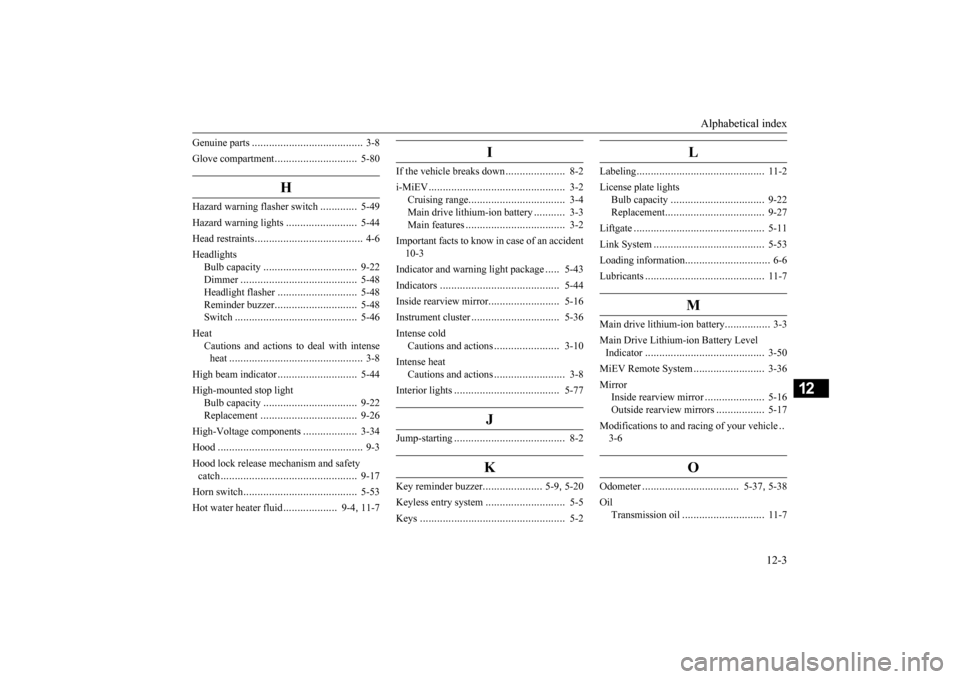
Alphabetical index
12-3
12
Genuine parts
.......................................
3-8
Glove compartment
.............................
5-80
H
Hazard warning
flasher switch
.............
5-49
Hazard warning lights
.........................
5-44
Head restraints
......................................
4-6
Headlights
Bulb capacity
.................................
9-22
Dimmer
.........................................
5-48
Headlight flasher
............................
5-48
Reminder buzzer
.............................
5-48
Switch
...........................................
5-46
Heat
Cautions and actions to
deal with intense
heat
...............................................
3-8
High beam indicator
............................
5-44
High-mounted stop light
Bulb capacity
.................................
9-22
Replacement
..................................
9-26
High-Voltage components
...................
3-34
Hood
...................................................
9-3
Hood lock release me
chanism and safety
catch
................................................
9-17
Horn switch
........................................
5-53
Hot water heater fluid
...................
9-4
, 11-7
I
If the vehicle breaks down
.....................
8-2
i-MiEV
................................................
3-2
Cruising range
..................................
3-4
Main drive lithium-ion battery
...........
3-3
Main features
...................................
3-2
Important facts to know in
case of an accident
10-3 Indicator and warning light package
.....
5-43
Indicators
..........................................
5-44
Inside rearview mirror
.........................
5-16
Instrument cluster
...............................
5-36
Intense cold
Cautions and actions
.......................
3-10
Intense heat
Cautions and actions
.........................
3-8
Interior lights
.....................................
5-77
J
Jump-starting
.......................................
8-2
K
Key reminder buzzer
.....................
5-9
, 5-20
Keyless entry system
............................
5-5
Keys
...................................................
5-2
L
Labeling
.............................................
11-2
License plate lights
Bulb capacity
.................................
9-22
Replacement
...................................
9-27
Liftgate
..............................................
5-11
Link System
.......................................
5-53
Loading information
..............................
6-6
Lubricants
..........................................
11-7
M
Main drive lithium-ion battery
................
3-3
Main Drive Lithium-ion Battery Level Indicator
..........................................
3-50
MiEV Remote System
.........................
3-36
Mirror
Inside rearview mirror
.....................
5-16
Outside rearview mirrors
.................
5-17
Modifications to and
racing of your vehicle
..
3-6
O
Odometer
..................................
5-37
, 5-38
Oil
Transmission oil
.............................
11-7
BK0220401US.book 3 ページ 2015年6月3日 水曜日 午前7時42分